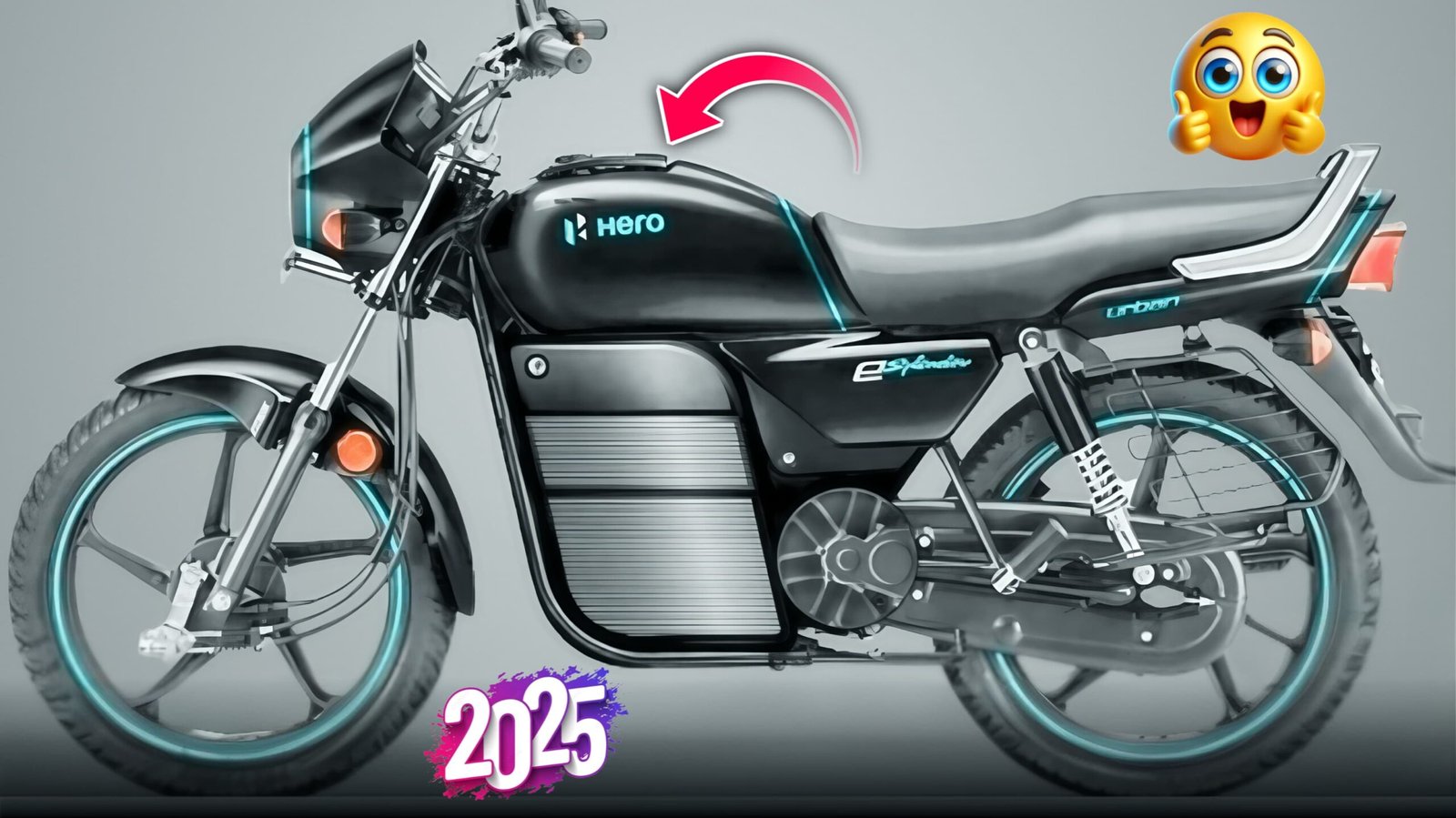The iconic Hero Splendor – renowned for its reliability, exceptional mileage, and affordability in India’s two-wheeler segment – is gearing up for a transformation into the electric age. The upcoming Hero Splendor Electric (internally codenamed AEDA) is Hero MotoCorp’s ambitious attempt to electrify one of its most trusted models. Slated for a 2027 launch, this urban commuter EV promises a blend of loyalty to the original and modern EV innovations.
Why the Splendor Electric
- Mass-market potential: With vast penetration in tier-II and III cities, Hero intends to shift around 200,000–250,000 units annually.
- Stepping-stone evolution: Moving from petrol to electric without alienating existing riders—retaining the familiar Splendor DNA.
- Ecosystem advantage: Powered by Hero’s expansive R&D and dealer network, reinforced by upcoming capacity expansions in Chittoor and Jaipur.
Design & Ergonomics
- Familiar silhouette: Upright riding ergonomics, slim profile, and commuter-friendly dimensions remain intact, preserving the visual connect of the petrol Splendor.
- EV-specific design: Tank-shaped storage compartment where the fuel tank used to be, fresh LED lighting, alloy wheels, and upgraded graphics lend a subtle yet confident EV identity.
Powertrain & Performance
- Electric motor: Likely a 3 kW hub-mounted motor delivering instant torque, ideal for stop-and-go urban traffic.
- Top speed: Estimated in the region of 60–70 km/h—sufficient for efficient city commutes.
- Battery setup: Removable lithium-ion battery pack, reminiscent of scooters, offering the convenience to charge anywhere.
- Regenerative braking: Energy efficiency and enhanced range via regenerative braking technology are on the cards.
Range & Charging Capability
- Impressive range: From 150 km (mid-range) up to 210–250 km in top variants, making it one of the highest mileage electric bikes in its category.
- Charging time: Around 3–5 hours on a standard wall socket—comparable to electric scooters.
- Battery flexibility: A removable battery means no fixed charging station requirement—ideal for apartment dwellers or office charging.
Safety & Rider Aids
- ABS system: Counterpart to the petrol model’s setup; anti-lock braking ensures safer stops, even on slippery roads.
- Digital instrument cluster: Functions like speedometer, state-of-charge, trip info, and battery alerts are accessible on a modern display.
- LED lighting: Eye-catching visuals and improved visibility in traffic.
Tech & Connectivity Features
- Bluetooth-enabled console: Likely to support phone pairing for incoming call/SMS alerts and possible navigation suggestions .
- Riding modes: Potential variants include Eco, City, and Sport modes to adapt range vs. performance.
- Convenience features: USB charging, keyless start, and possibly a reverse mode on premium trim levels.
Affordability
- Expected pricing: Around ₹99,000 – ₹1.10 lakh (ex-showroom), aligning with Hero’s legacy of value-packed offerings.
- Lower running costs: Estimated at ₹0.25–₹0.30 per km vs. ₹2–₹3/km for petrol variants, resulting in up to 80% savings for daily commuters.
- Minimal upkeep: No clutch, spark plugs, oils—just brake checks, tire wear assessments, and occasional software updates.
Variants
Expect a range of trims tailored to rider priorities:
| Variant | Features |
| Base | ~210 km range, basic digital console, single power mode |
| Mid | ~230 km, enhanced display, dual riding modes, better LED |
| Top | ~250 km, full-color TFT screen with navigation, keyless start, reverse mode |
Ownership Experience
- Ride feel: Quiet, no vibrations, and instant torque—modern yet nostalgic.
- Ease of use: Single-speed, user-friendly controls akin to petrol Splendor.
- Charging simplicity: Detachable battery means no range anxiety—plug and charge from home or office.
Hero’s EV Roadmap
- The Splendor Electric is integral to Hero’s 2027 EV lineup—which includes performance-oriented bikes (150c and 250c equivalents, code-named ADZA) and electric dirt bikes (Vida Lynx).
- Goal: Lift Hero’s annual EV sales to over half a million units by 2027‑28.
Challenges & Considerations
- Launch timeline: Expected only by mid-2027, so early EV adopters might wait.
- Real-world range: The claimed 250 km will vary depending on load, traffic, and ride style.
- Infrastructure readiness: Though removable battery reduces dependency, widespread charging and servicing setups will be essential.
Conclusion
The Hero Splendor Electric has the potential to reshape electric two-wheeler adoption in India. It combines:
- A trusted brand legacy
- Low long-term running cost
- High urban practicality
- Progressive tech features
- Comfort akin to its petrol counterpart
If Hero delivers on these specifications, the Splendor Electric could emerge as a game-changer—ushering in an EV revolution without compromising on what made it legendary in the first place.
FAQs
Q1: When is the Hero Splendor Electric launching?
A: Expected in mid-2027, as part of Hero’s mass-market EV expansion.
Q2: What is its claimed range?
A: Between 150 km (entry trims) to 210–250 km in top variants.
Q3: How fast can it go?
A: Likely 60–70 km/h, ideal for city and suburban commutes.
Q4: Is the battery removable?
A: Yes, it is a removable lithium-ion pack, facilitating flexible charging.
Q5: Will it have ABS?
A: Yes, with features like ABS and regenerative braking on all trims.
